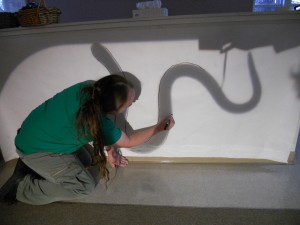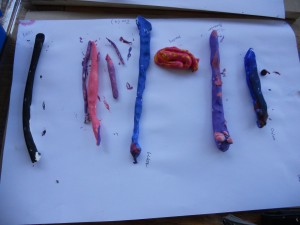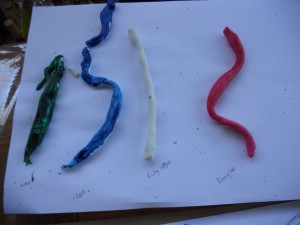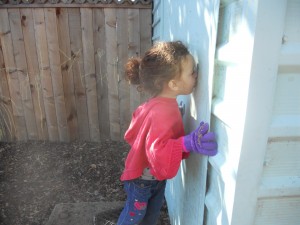By Emily Vorspan
 Around six weeks ago I was sitting with a few children on the playground where we began a conversation about how and why rattlesnakes use their rattle. A few days later the children listened to a Native American story “Baby Rattlesnake” about a young rattlesnake who misuses its rattle and in the end it is stepped on and crushed.
Around six weeks ago I was sitting with a few children on the playground where we began a conversation about how and why rattlesnakes use their rattle. A few days later the children listened to a Native American story “Baby Rattlesnake” about a young rattlesnake who misuses its rattle and in the end it is stepped on and crushed.
 The next day a child requested the same book for our grouptime. At the end I posed the question, “I wonder if a rattlesnake can grow another rattle?” I suggested that they ask their parents to do some research with them at home and report back. Next one child suggests we draw pictures of snakes and another child had an idea that we should create a book based on “Baby Rattlesnake.” I left school that day thinking we may be beginning a “project.”
The next day a child requested the same book for our grouptime. At the end I posed the question, “I wonder if a rattlesnake can grow another rattle?” I suggested that they ask their parents to do some research with them at home and report back. Next one child suggests we draw pictures of snakes and another child had an idea that we should create a book based on “Baby Rattlesnake.” I left school that day thinking we may be beginning a “project.”
What is a project? Todd Wannerman (a great presenter at NAEYC) in his book Using The Project Approach With Toddlers and Twos offers a definition: “A project is a common undertaking that requires organizing, negotiating, and collaborating. To work on a project means to look forward, to predict outcomes, to set something in motion and shape it as it evolves and changes, and perhaps most of all, to express your inner self in visible ways.”
 I decided I wanted to try and keep this conversation about rattlers going. Here is a rough timeline of conversations and activities that have been taking place over the past weeks.
I decided I wanted to try and keep this conversation about rattlers going. Here is a rough timeline of conversations and activities that have been taking place over the past weeks.
We share some research. I’m amazed by how much children already know and we learn the word and action shedding.
We draw rattlesnakes and words are written down about their drawings. They are exhibited and words are read back to them during grouptime.
 We have numerous conversations about how not only a rattlesnake but other creatures in the wild protect and defend themselves. We talk about wild verses domestic animals and read stories to further our understanding. Using the overhead we play with socks as snake puppets in the shadows and light. We are wild! We create a snake mural. Our helping parent get us started by tracing a play snake projected onto the paper.
We have numerous conversations about how not only a rattlesnake but other creatures in the wild protect and defend themselves. We talk about wild verses domestic animals and read stories to further our understanding. Using the overhead we play with socks as snake puppets in the shadows and light. We are wild! We create a snake mural. Our helping parent get us started by tracing a play snake projected onto the paper.
One child brings in a five foot long rattlesnake skin. We feel it and observe the shapes and colors and describe the texture.
 We attempt to draw diamond shapes. We talk about what a habitat is. I talk to Kerry along the way. She decides to have each child create a snake out of a paintable claylike material. She will also work with each child on a habitat for their snake and a story to go along with it.
We attempt to draw diamond shapes. We talk about what a habitat is. I talk to Kerry along the way. She decides to have each child create a snake out of a paintable claylike material. She will also work with each child on a habitat for their snake and a story to go along with it.
I wonder if “Baby Rattlesnake” will return?
 I feel a bit like the mouse in If You Give A Mouse A Cookie, one thing leads to another thing and so on till he ends up back where he started. I like the way we can take this conversation and the activities going in so many different directions and still keep the thread of the snake going. We can keep returning to the beginning of it all. Repetition is key for learning.
I feel a bit like the mouse in If You Give A Mouse A Cookie, one thing leads to another thing and so on till he ends up back where he started. I like the way we can take this conversation and the activities going in so many different directions and still keep the thread of the snake going. We can keep returning to the beginning of it all. Repetition is key for learning.
With this “project” underway, I hope to share some of the children’s drawings and snakes at the workshop this coming week with one of the developers of the Project Approach, Lillian Katz and bring a new perspective to the work we’re doing. In the meantime it has been a delight to see the children’s excitement, to hear them share what they know, and listen to them imagine where they want their snake to live. I look forward to seeing them develop these sculptures and I hope to share them with the Coop community.
 My next blog will be about my Tuesday/Thursday class. We love HOLES! Holes in the shed outside, in the fence, in tunnels as we play with blocks, making holes in clay etc. We’ll see where this goes.
My next blog will be about my Tuesday/Thursday class. We love HOLES! Holes in the shed outside, in the fence, in tunnels as we play with blocks, making holes in clay etc. We’ll see where this goes.
Have a lovely Spring Break.
Emily
